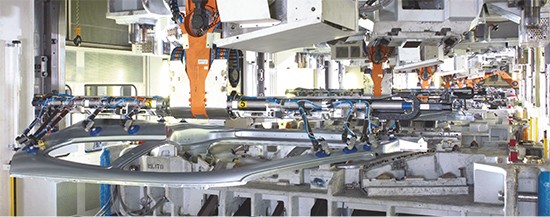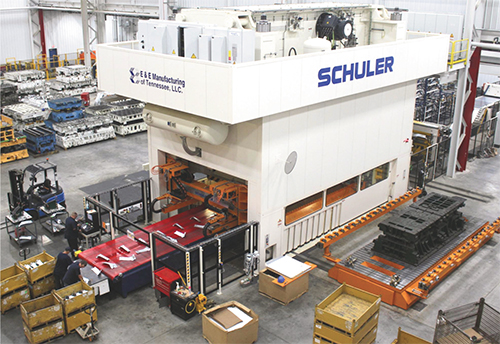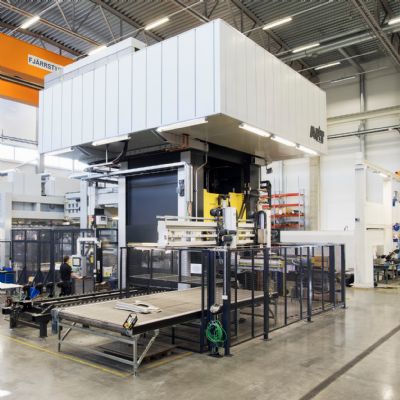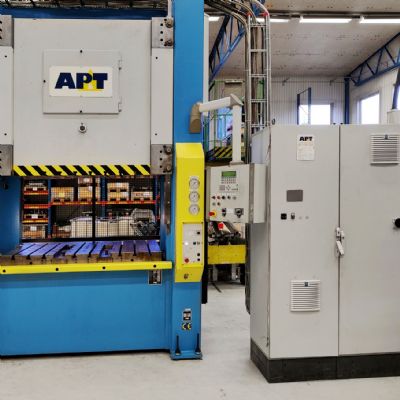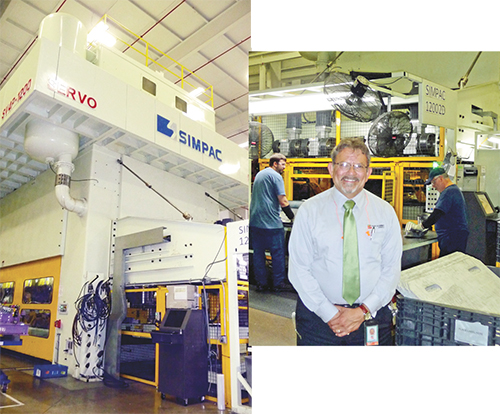 |
| Michael Hylton displays recent stamped parts coming off of Thai Summit’s new 1200-ton Simpac servo-transfer press: rear-wheel-opening reinforcements stamped from 0.9-mm-thick 6000-series aluminum sheet. The press, identical to another Simpac servo press installed in 2014, features an 800-mm max and 200-mm adjustable slide length. Its transfer system offers 1524-mm max. feed stroke, 400-mm clamp stroke and 200-mm lift stroke. |
With its new-found ability to take on even larger and more complex parts, due to the ability of the larger bed to handle dies with more press stations, E&E already has earmarked 28 die sets for the new press, for Mercedes and BMW programs.
“The market is tight for work on these types of presses,” Scherle says. “Few if any stampers have excess capacity on their large transfer presses. That helped convince us to move forward with this new capital investment and position ourselves to earn new work.”
The Speed Advantage
However, it’s not just new work that has found its way to the press. Scherle describes one of the six jobs that it has moved from its older, traditional transfer presses that have received big productivity boosts when running on the new Schuler servo model:
“The job at hand is a visible, exposed automotive part stamped from 2-mm-thick DP800 AHSS, which ran at 14 strokes/min. on one of our older transfer presses. Now running on the servo press, by tailoring the press curve and quickening the overall transfer and feed-line process we increased run rate to 24 strokes/min., a nice boost in productivity.”
To help engineers find opportunities to optimize the stamping process, E&E employs a Schuler software tool called Transfer Pro, which it supplies as an add-on with its servo presses.
“After we get our dies inhouse,” Scherle explains, “which have previously been optimized in AutoForm and completely simulated (including transfer simulation), we plug them into the Schuler optimization software and often gain significant speed advantages.”
|
Servo Technology. October. Cleveland
F rom the corner office to the shop floor, you can reap big benefits by attending the Servo Technology Experience, powered by MetalForming magazine and the Precision Metalforming Association. The two-day technical conference, October 3-5 in Cleveland, OH, covers state-of-the-art servo technology used in presses, transfer systems, coil-feed lines and more. The Servo Technology Experience will provide technical presentations and case studies describing how modern servo-based equipment can help stampers improve productivity and quality. rom the corner office to the shop floor, you can reap big benefits by attending the Servo Technology Experience, powered by MetalForming magazine and the Precision Metalforming Association. The two-day technical conference, October 3-5 in Cleveland, OH, covers state-of-the-art servo technology used in presses, transfer systems, coil-feed lines and more. The Servo Technology Experience will provide technical presentations and case studies describing how modern servo-based equipment can help stampers improve productivity and quality.
Day one of the conference will focus on servo-press technology, and include scheduled breakout sessions with leading press suppliers. Here, attendees will have the opportunity to network with industry thought leaders and gain unique insights into how this technology is leading the evolution in the metal-stamping industry, and where the technology is headed.
Day two of the conference turns attention to transfer systems, coil-feed lines and other servo-based technology prevalent in pressrooms. Attendees will learn how these systems work in unison to lead stampers to increased performance and profitability.
To register or for more information, visit www.metalformingmagazine.com/servo.
|
Transfer Pro optimizes servo-press kinematics, according to Schuler, taking into account the transfer curves and the coil-feed capabilities. “We often takes jobs estimated to run at 14 to 16 strokes/min.,” shares Scherle, “and optimize them in the Schuler software to run at 20 to 22 strokes/min.”
The Trim Advantage
In addition to appreciating the ability to gain additional strokes/min., Scherle also boasts of the presses’ ability to avoid splits when forming difficult AHSS parts.
“We run AHSS exclusively on our two servo presses now,” he says. “The presses are tight with little or no play, and they are very controllable. Forming AHSS requires your tools to be in excellent condition, and the way that the servo presses operate really protects our tools. That provides very tight clearances, and, therefore, perfect trim and shear conditions. Without those conditions, any edge imperfection—the tiniest microcrack—with AHSS will propagate into a split during forming. We seek perfect trim conditions, and the servo presses give us that.”
Servos Deliver Speed, Force Control for Aluminum Stamping
Within in the last few years, two huge servo-transfer presses have joined the ranks at the Thai Summit America’s 1-million-plus-square-ft. stamping and assembly facility in Howell, MI. The big-bed (7300 by 2300-mm bolster) 1200-ton presses, both Simpac models, joined, in 2014 and 2015, respectively, two other servo presses previously installed at the facility. They allow the firm to take on an increasing amount of aluminum stamping for the Ford F150 program; it also supplies the Ford F250 and F350, and the Ford Escape programs.
Thai Summit America, which in 2009 took over the facility previously operated by Ogihara, stamps parts as small as 4 by 4 in. to as large as 13 by 7 ft., using transfer presses and tandem lines with press capacity to 2700 tons. The company, known for its deep-draw expertise, has vast experience stamping high-strength steels and tailor-welded blanks, although aluminum projects for the F150 now account for half of its output.
“When Thai Summit moved into this facility,” says executive manager of purchasing C. Michael Hylton, “we felt we needed to develop a more efficient stamping operation. The systems in place were good but we needed to get to the cutting edge. Servo presses were a big part of that plan to become more competitive, especially for stamping aluminum.”
Speed and Force Control
Two servo presses (800 and 1200 tons) were first on the scene, joining in 2013 the firm’s existing transfer presses, tandem lines and tryout presses, along with assembly bays. Then, in 2014 Thai Summit brought in the first of its two Simpac transfer presses, the first equipped with a Feed Lease servo-feed line “engineered to handle aluminum coil stock and to prevent marking or buildup on the rolls,” says Hylton. Also included were Wayne Trail servo-transfer systems that feature a half-pitch cycle option.
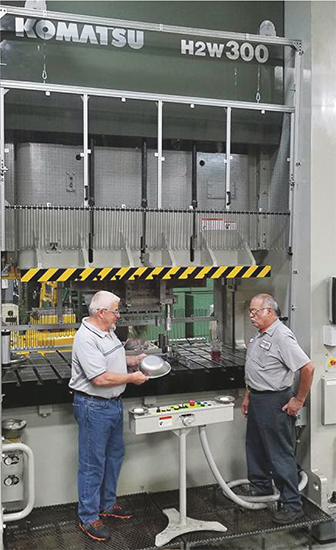 |
| Manor Tool and Manufacturing Co. production supervisor Carlos Ruvalcaba and toolroom manager Dan Kiraly review a successful deep-draw project completed recently on the firm’s new 330-ton servo-mechanical press. |
“That half-pitch feature,” adds Hylton, “enables the process designer to specify a different transfer-pitch distance at the beginning of the cycle, during blanking, than for the rest of the process.”
The second transfer press, added in 2015, features a coil line and transfer system completely integrated by Simpac. “From a purchasing standpoint,” says Hylton, “the presses perform as expected. Our team appreciates the ability to control the ram speed anywhere in the cycle to help with forming, and we can run progressive dies in the pendulum mode and maximize the stroke rate. We can run prog. dies at 40-plus strokes/min., and transfer dies at speeds to 32 strokes/min. Where we need precise control of ram speed in difficult forming applications, we can slow the stroke rate to, for example, 12 strokes/min. at the bottom of the stroke, then then run the rest of the press cycle at 30 or more strokes/min., to maintain a good, fast average pace.
“The servo presses also tend to run on less electricity to generate the tonnage required,” Hylton adds. ”This, combined with the fact that aluminum requires less tonnage than does steel to form into the desired shapes, introduces another cost advantage to using the servo concept for stamping.”
Of course, meeting tight assembly-plant deadlines and ever-increasing volumes (part runs average 12,000 to 15,000 and the presses undergo die changes three times/day) requires solid overall equipment effectiveness, and that’s exactly what Thai Summit has experienced. Says executive manager of plant maintenance Ed Phillips:
“I look at availability and press time, and the performance charts for these newer servo-transfer presses are impressive; both presses are running at greater than 97 percent availability.”
The presses run some 60 different parts for the F150 program from a handful of dies, from 0.7- to 3.5-mm-thick aluminum in the 5000- and 6000-series grades.
Mitigating the Damage from Reverse Tonnage on Thick Stock
“Shearing 3.5-mm stock,” says Matt Reed, a first-shift supervisor in the firm’s press-maintenance group, “can cause a lot of reverse tonnage and vibration in the entire press system. The ability to slow the ram at the bottom of the stroke minimizes that shock and prevents damage to the press and the tools.”
“Our dies are designed and optimized to run in the servo presses,” adds Hylton. “Using AutoForm to run forming-process simulation, we can optimize the stamping process using the unique capabilities of the servo presses to help us overcome issues with thinning and fracturing, etc. And, where simulations don’t identify forming issues, we can be less selective about which press we employ for a given job.
“Further,” he continues, “once we identify the tonnage needed to perform all of the required piercing, forming and trimming for a job, we then look at speed—how fast do we need to run a job? Faster typically means we run it on the servo presses.”
Resting on its Laurels? Hardly
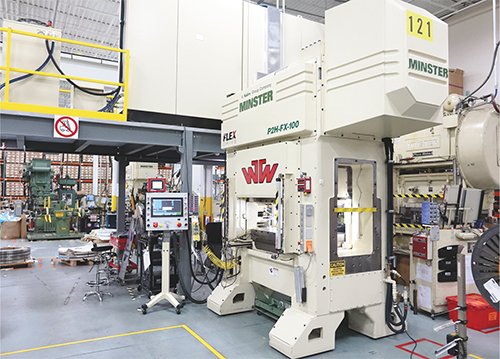 |
| A new 100-ton servo press at Wiegel Tool Works (WTW) satisfies the company’s need for speed while offering endless advantages versus a standard mechanical press, including increased drawing capabilities, according to Ryan Wiegel, WTW vice president. |
Thai Summit America continues to expand, and will soon launch production of aluminum stampings and assemblies for the 2018 Ford Expedition/Navigator program, as well as for the Tesla Model 3.
“Thai Summit is expanding,” says Hylton. “We have a new facility opened recently in Kentucky that, in addition to a tandem line and servo-transfer press, also houses a second huge transfer press that we will customize to make it behave similarly to a servo. And, some of the Expedition/Navigator work will run in Kentucky as well.”
Servo-Mechanical: The Flexibility of Hydraulic, with Greater Speed
“I think a servo-mechanical press covers probably 80 percent of the work that a hydraulic press can perform, but nearly 100 percent of what we would need the press to do,” is how Manor Tool and Manufacturing Co. president/ owner Tom Simeone positions the company’s recent investment in a 330-ton Komatsu servo-mechanical press. “We see the press as filling the bill of a hydraulic, but also able to be a revenue generator for us and compete with our other traditional presses.”
Manor Tool, which operates two facilities in Illinois—a stamping and sheetmetal-fabrication shop in Schiller Park, and a die shop in Addison—eyes at least two specific applications for its newest press: coining and deep drawing. Added to the company’s 30-press stable in September of 2016, the press promises to fuel management’s desire to add flexibility to its operations, and attract new business.
Touting Servo’s Benefits Package
After modifying the bolster of the press to fits its pressroom’s quick-die-change scheme, Manor’s production crew quickly recognized it as the perfect backup to its existing 400-ton eccentric-drive mechanical press, as well as eyeing all of the benefits touted with servo technology. Komatsu supplied Manor with an H2W 300S model with an 11.8-in. max stroke, 31.4-in. shut height, 7.8-in. slide adjustment and 94.5 by 47.2-in. bolster. Manor Tool sales manager John Creighton explains, in a blog post that appeared on the company website earlier this year, the benefits of the technology:
“This press will serve as an important addition to our shop’s advanced metal-stamping capabilities. Incorporating state-of-the-art AC servo-drive technology with two variable-speed motors, the press will allow us to expand our design possibilities (servo presses are capable of dwelling anywhere within a stroke as well as changing the slide’s velocity during the stroke) with multistroke capabilities. We also expect to see an increase in the operating life of our dies (operating a servo press will allow us to reduce tonnage by as much as 20 percent on existing tools), all while reducing energy consumption and maintenance downtime.”
Diversification Defined
The management team at Manor Tool and Manufacturing focuses on building a diversified portfolio of capabilities, processing a range of parts and materials including 0.005-in. phosphor bronze as well as 3⁄16-in.-thick quarter-hard stainless steels, aluminum-alloy sheet, as well as plate to 3⁄8 in. thick. Its customer base includes OEMs in the aftermarket-automotive, heavy-construction and metal-furniture markets. In addition, the firm actively seeks R&D opportunities to improve every facet of its operation. Two recent such cases (in addition to adopting servo-press technology): development of new tool coatings and of low-cost dies.
“We have two R&D projects underway at the University of Chicago at Urbana-Champaign,” explains Simeone, “to study tool coatings for heavy-duty forming and to look at different materials and methodologies for lower-cost dies. Our partners on the tool-coating study already have begun to apply some of the project results to develop new coatings, and we have built eight stamping dies incorporating some of the lessons learned from the low-cost-tooling study.”
Another more immediate project completed at the company: adding, in August of 2017, a Coe SpaceMaster servo-based compact coil-feed line to its new Komatsu press, to create a complete servo-based system. The line handles coil stock to 40 in. wide by 18 in. thick (1⁄4-in. stock at a 10-in. coil width).
“Deep-draw and coining applications account for some 45 percent of our work,” says Simeone, “and we expect continued growth in those two areas. The coil-fed servo-press line will support that growth.
“And, thinking about other possibilities, as we tend to do here,” he ponders, “I wonder how the servo press might perform in shaving operations, which we do a lot of in order to eliminate creep-feed grinding on some of our parts. That’s another interesting application where the servo press may help us.”
Wiegel Tool Works Goes Servo for the Speed
Wiegel Tool Works, Inc. (WTW), Wood Dale, IL, specializes in precision metal stampings for several markets including aerospace, automotive, electronics, telecom and more. As a contract manufacturer, the company sees jobs with part quantities by the thousands to millions per year and with numerous geometries; thus the need for flexibility and the reason why the company has been on the lookout for a servo press since the 1990s. Even then, servo technology displayed capabilities beyond the traditional mechanical presses of the day, and has only improved over the years since.
Finally, in November 2015, WTW took the plunge and purchased its first servo press, a P2H-FX-100 from Nidec Minster. In production since 2016, the 100-ton press has performed exceptionally well on numerous jobs even though, as Ryan Wiegel, WTW vice president, admits, the company has only scratched the surface of what a servo-driven press can do. Where the machine has earned its keep thus far, according to Wiegel, is speed.
“Why didn’t we buy a servo press sooner?” he asks. “Using the latest servo technology, this press can run at speeds to 250 strokes/min., which was once unheard of for these types of presses. Before, with a 3-in. stroke, we would see machines top out at 70-100 strokes/ min. at best. Finding a press with this type of speed really made the decision for us.”
Wiegel also notes the liquid-cooled servo motors that enable increased production speed, which he sees as an advantage over fan cooling. Liquid-cooling servo-motor technology consistently provides more usable power than comparable air-cooled motors, according to Nidec Minster officials, in addition to maintaining thermal stability and cooler operating temperatures. These attributes also result in increased press-component life.
Offers ‘Endless Advantages’
“The advantages of a servo press are endless versus a standard mechanical press,” Wiegel says. “I’ve read where some stampers actually have eliminated preforming on their tools due to the ability to control the press stroke. Servo presses also offer real advantages when drawing, even though we are limited in the amount of drawing we perform. Already we have noticed that some of the right-angle brackets we produce, which have presented problems in most mechanical-press motions, are now easily produced in our servo press.”
Other features of Wiegel’s new servo press include a low-inertia drive engineered to enable higher acceleration and deceleration rates. Lower torque requirements also result in higher-efficiency forming, according to Nidec Minster officials. In addition, the eccentric-shaft design reportedly creates improved dynamic parallelism and bottom-dead-center accuracy, and minimizes backlash for consistent accuracy in pendulum mode.
Beyond that, beefed-up construction allows the press to withstand the force generated when stamping the latest high-tensile-strength materials, and an operator-friendly HMI provides the ability to quickly choose from highly customizable slide-motion profiles.
But again, it is the speed that has most impressed Wiegel and WTW.
“For the specialized type of work that we perform, we could find no other option than this press due to its speed and versatility,” Wiegel says. “For stamping that requires 100-ton capacity and up, we will only purchase servo presses.” MF
Industry-Related Terms: Bed,
Blanking,
Breakout,
Case,
Coining,
Corner,
Die,
Draw,
Drawing,
Edge,
Form,
Forming,
Grinding,
Hydraulic Press,
Lines,
Model,
Phosphor Bronze,
Piercing,
Plate,
Ram,
Run,
Shut Height,
Stroke,
Surface,
Torque,
TransferView Glossary of Metalforming Terms
See also: HYSON, Coe Press Equipment Corporation, Nidec Press & Automation, Komatsu America Industries, LLC Press Technology Division, Universal Feed & Machine, Inc.
Technologies: Stamping Presses
